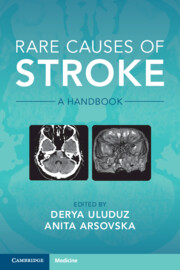Book contents
- Rare Causes of Stroke
- Rare Causes of Stroke
- Copyright page
- Contents
- Contributors
- Preface
- 1 Inflammatory Conditions
- Chapter 1.1 Isolated Vasculitis of the Central Nervous System
- Chapter 1.2 Primary Systemic Vasculitis
- Chapter 1.3 Vasculitis Secondary to Systemic Disease
- Chapter 1.3 Chapter
- 2 Infectious and Postinfectious Vasculitis
- 3 Hypercoagulable Causes of Stroke
- 4 Drug-Related Stroke
- 5 Hereditary and Genetic Causes of Stroke
- 6 Rare Causes of Cardioembolism
- 7 Vasospastic Conditions and Other Vasculopathies
- 8 Other Non-inflammatory Vasculopathies
- 9 Venous Occlusive Conditions
- 10 Bone Disorders and Stroke
- Index
- References
Chapter 1.3 - Chapter
from 1 - Inflammatory Conditions
Published online by Cambridge University Press: 06 October 2022
- Rare Causes of Stroke
- Rare Causes of Stroke
- Copyright page
- Contents
- Contributors
- Preface
- 1 Inflammatory Conditions
- Chapter 1.1 Isolated Vasculitis of the Central Nervous System
- Chapter 1.2 Primary Systemic Vasculitis
- Chapter 1.3 Vasculitis Secondary to Systemic Disease
- Chapter 1.3 Chapter
- 2 Infectious and Postinfectious Vasculitis
- 3 Hypercoagulable Causes of Stroke
- 4 Drug-Related Stroke
- 5 Hereditary and Genetic Causes of Stroke
- 6 Rare Causes of Cardioembolism
- 7 Vasospastic Conditions and Other Vasculopathies
- 8 Other Non-inflammatory Vasculopathies
- 9 Venous Occlusive Conditions
- 10 Bone Disorders and Stroke
- Index
- References
Summary
Behçet’s syndrome (BS), originally described in 1937 by the Turkish dermatologist Hulusi Behçet, as a distinct disease with oro-genital ulceration and uveitis known as the “triple-symptom complex”, is an idiopathic chronic relapsing multisystem vascular-inflammatory disease of unknown origin. The condition that features primary neurological involvement is termed as neuro-Behçet syndrome (NBS). Based on the clinical and neuroimaging features, primary BS neurological involvement may be divided into two major forms: 1) parenchymal NBS (p-NBS); and, 2) vascular NBS. Cranial neuropathy, dysarthria, ataxia, hemiparesis, and headache are the major symptoms of p-NBS, with headache being the most prevalent (in patients with both p-NBS and neuro-vascular involvement). Lesions revealed by magnetic resonance imaging are most common in the mesodiencephalic junction followed by the pons/medulla oblongata. Vascular involvement (the second most common form of neurological involvement) is associated with a better prognosis than p-NBS, and the clinical manifestations vary by the site and extension of venous thrombosis. During the acute phase of p-NBS, the cerebrospinal fluid shows inflammatory changes in most cases of p-NBS with an increased number of cells, up to a hundred and sometimes more per ml, neutrophils being mostly the predominating cells and modestly elevated protein levels. Patients with BS-CVST do not exhibit any remarkable cerebrospinal fluid finding apart from an increased pressure. Currently, the only drug that have been shown to be effective based on the Class IV evidence is infliximab for the treatment of p-NBS
Keywords
- Type
- Chapter
- Information
- Rare Causes of StrokeA Handbook, pp. 72 - 78Publisher: Cambridge University PressPrint publication year: 2022



